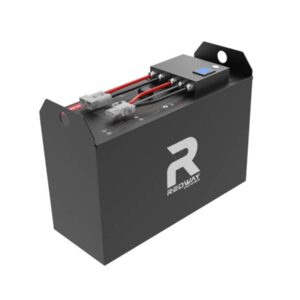How to maximize battery life span?
Maximizing battery lifespan requires avoiding extreme temperatures, partial discharge cycles (20–80% SoC), and using matched chargers. Regular maintenance like cell balancing and firmware updates ensures BMS accuracy. Store at 50% SoC in cool, dry environments. LiFePO4 benefits from lower peak voltages (3.65V/cell) versus NMC’s 4.2V, reducing stress. Pro Tip: Never leave batteries at 100% SoC for over 48 hours—accelerates cathode degradation.
How to Maximize Forklift Battery Lifespan
What charging habits extend battery life?
Partial charging (20–80% SoC) and avoiding trickle charging post-100% are key. Use chargers with ≤1% voltage tolerance to prevent overcharging. CC-CV phases must terminate correctly—LiFePO4 stops at 3.65V/cell, NMC at 4.2V.

Deep Dive: Charging to 100% weekly stresses anodes via lithium plating. For example, charging a 72V LiFePO4 pack to 84V daily degrades cells 30% faster than stopping at 80V. Pro Tip: Set charger endpoints to 90% capacity unless range is critical. Transitional: Beyond voltage limits, charge rate matters. >0.5C (e.g., 50A for 100Ah) increases heat, accelerating electrolyte breakdown. But what if you need fast charging? Prioritize packs with cooling systems.
| Charge Habit | Cycle Life | Capacity Loss/Year |
|---|---|---|
| 20–80% SoC | 1,500+ | 2–3% |
| 0–100% SoC | 500–700 | 8–10% |
How does temperature affect lifespan?
Heat above 45°C and freezing below 0°C degrade batteries. High temps accelerate SEI growth, while cold causes lithium plating during charging.
Deep Dive: At 35°C, NMC loses 15% capacity yearly versus 5% at 25°C. Pro Tip: Delay charging frozen batteries until they reach 10°C. For example, a forklift battery stored in -10°C warehouses needs 2–3 hours to warm before charging. Transitional: Practically speaking, thermal management systems add cost but boost longevity.
| Temp Range | Annual Degradation | Solution |
|---|---|---|
| >45°C | 20–25% | Active cooling |
| -20°C to 0°C | 10–15% | Insulated housing |
Rhetorical: Why risk 5-year packs dying in 2 years?
Why avoid full discharge cycles?
Deep discharges below 10% SoC strain cell structure, causing voltage sag and micro-shorts. LiFePO4 handles 20% better than NMC but still degrades.
Deep Dive: Discharging a 100Ah battery to 0% weekly reduces lifespan by 40% versus stopping at 20%. Pro Tip: Set BMS low-voltage cutoffs to 20% SoC. Transitional: Beyond cell damage, full cycles generate more heat. For example, e-scooters draining batteries to 5% daily lose 25% capacity in 8 months. Rhetorical: Is that extra mile worth replacing packs yearly?
Does storage method matter?
50% SoC and 15–25°C are ideal for storage. Batteries lose 2–4% monthly; BMS sleep modes reduce parasitic drain.
Deep Dive: Storing a 72V LiFePO4 at 100% for 6 months loses 8–12% capacity versus 3% at 50%. Pro Tip: Recharge stored batteries to 50% every 3 months. Transitional: Consider self-discharge rates—NMC loses 3% monthly, LiFePO4 1–2%. For example, warehouse backup batteries stored improperly require premature replacement.
Role of BMS in longevity?
Battery Management Systems balance cells, enforce voltage limits, and monitor temps. Advanced BMS optimize charge acceptance and log degradation trends.
Deep Dive: A 16S LiFePO4 BMS with ±10mV balancing prevents weak cells from overcharging. Pro Tip: Update BMS firmware quarterly—manufacturers often improve algorithms. Transitional: Without balancing, a single 3.2V cell hitting 3.8V can trigger thermal runaway. For example, mismatched cells in e-bike packs cause 30% capacity divergence in 6 months.
How to monitor battery health?
Track internal resistance and capacity fade via BMS logs or diagnostic tools. A 20% resistance increase or 15% capacity loss signals maintenance.
Deep Dive: Use impedance spectroscopy monthly—a 100Ah pack with >25mΩ resistance per cell needs replacement. Pro Tip: Calibrate BMS SoC readings annually by fully cycling the battery. Transitional: For fleets, cloud-based monitoring predicts failures. Rhetorical: Would you drive a car without a fuel gauge?
Battery Expert Insight
FAQs
Should I fully discharge my battery occasionally?
No—modern batteries don’t require calibration via full cycles. It only accelerates wear.
Can software updates improve battery lifespan?
Yes—updated BMS firmware optimizes charging curves and balancing, often adding 10–15% cycle life.
